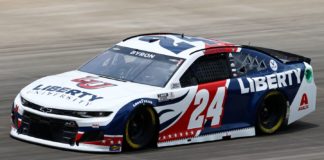It was an exciting day full of racing and entertainment at the LA Coliseum for last week’s Busch Light Clash, but now, we return to your regularly scheduled NASCAR programming! On Thursday night, we have the qualifying Duel races to set the full starting lineup for Sunday’s Great American Race, the Daytona 500. Each field will have about half the number of drivers as the actual race, making the winning strategies likely different than a typical race. Despite the new car, there are trends that should likely stay true in these races, so let’s dig in and see what we can find!
Daytona 500 Duels Race Details
Track: Daytona International Speedway
Length: 150 miles (60 laps)
Field Size: 22 cars
Projected Dominator Points Available: 38.5
The starting positions for these races are set by the single-car qualifying speeds in Wednesday’s session. Drivers qualifying in an odd-numbered position will be in Duel #1, while drivers qualifying in an even-numbered position will be in Duel #2. Of note, drivers who qualify on the front row for the Daytona 500 (pole sitters for the Duels) are locked into their starting position for Sunday regardless of their Duel finish.
Notable Race Trends to Take Advantage Of
- In 7 of the past 8 duel races, a driver starting on the front row (pole sitter 6 times) has led double-digit laps. However, in those same races, the polesitter has finished no better than 8th.
- Takeaway: While dominator points are enticing, chasing them is not necessary to create a winning DFS lineup in these races. In fact, it’s likely a losing strategy since the polesitter tends to be more conservative to protect their car for Sunday’s race.
- Daytona and Talladega are known for drafting and consequential carnage. However, over the past 4 years of Duel races, only 7.9% of eligible drivers have gained 10 or more positions in a race, while 15.7% of eligible drivers lost 10 or more positions in a race.
- Takeaway: Place differential is still important at Daytona, but it’s harder to come by in the Duel races. In these same races, there has been an average of 1.1 cautions, indicating less wrecks. Given the documented supply chain issues, expect teams (other than those who have to race their way in) to be more conservative to avoid damage to their car for Sunday.
- Over the past 12 Daytona Duel races, the winner has started no worse than 8th place. Further, each of the last nine Duels winners have started inisde the top 5.
- Takeaway: While other DFS players focus on dominators or place differential, an integral piece of a winning lineup is likely to come from strong finishes by drivers starting between 2nd and 8th. Not only is the winner likely to come from this range, they’re also likely to garner less ownership.
Optimal Lineup Review
- The past eight optimal lineups spent greater than $48,000 of salary.
- Takeaway: Though NASCAR is always open to variance, this trend makes sense given what was mentioned earlier. The lack of dominator points and drastic place differential condenses the range of points scored, allowing more drivers to achieve similar values.
- 7 of 8 optimal lineups rostered at least two drivers starting in the top 6, six of which had three drivers starting in the top 9.
- Takeaway: As discussed earlier, the race winner will likely come from this range. Likewise, with few drivers earning/losing significant place differential points, strong finishes from this range make great leverage plays.
- Only 8 of the 48 drivers (16%) appearing in an optimal lineup came from a starting position worse than 15th place.
- Takeaway: Starting positions from the back of these duels typically consist of drivers having to race their way into the Daytona 500 and lacking on speed. Inexperience also becomes an issue. Given the risks these drivers will take and the aforementioned ceiling on place differential, being underweight to the field on “stack the back” plays could be a profitable strategy.
Final Lap
Lineup construction can vary, especially at superspeedway, where more random events are likely to occur. However, chasing the optimal lineups for the Daytona Duels is easier when you recognize possible trends. Strategy will likely be similar to usual superspeedway races, but slightly different due to the shortened number of laps and drivers in the field. Focus on the data presented above, and, hopefully, you’ll be in victory lane on Thursday!
















